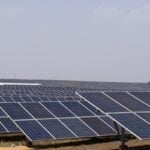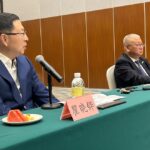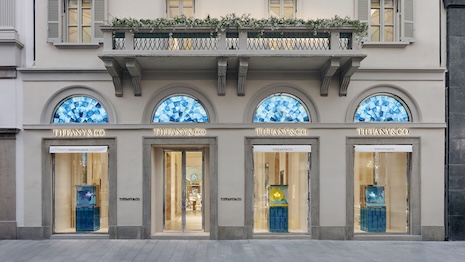Portuguese footwear industry to invest 600 million euros
Interview APICCAPS 2025 campaign image Credits: APICCAPS The Portuguese footwear, components, leather goods manufacturers association (APICCAPS), which represents the footwear industry in the country, is looking to invest 600 million euros in the industry by 2030 with a focus on innovation, sustainability, worker skills and international growth. “This is our largest investment ever. We believe that we can increasingly become a major international reference,” Paulo Gonçalves, spokesperson for APICCAPS, told FashionUnited. “We are not particularly focused on increasing production, as the sector already manufactures 80 million pairs of shoes a year; our main goal is to optimise processes and make the Portuguese footwear industry an international benchmark in the development of new products.” The 600-million-euro investment planned by the end of the decade includes two major projects already underway (BioShoes4All and FAIST), which are expected to be completed by the end of this year, in the areas of automation, digitalisation, and sustainability. Gonçalves added: “Every year, 22 billion pairs of shoes are produced internationally, 90 percent of which are in Asia, which means nine out of ten people wear Asian shoes. We don’t think this is sustainable. “We believe that it is possible to produce excellent footwear in Europe at fair prices and we are making the investment in areas such as automation, digitalisation, qualification, sustainability and internationalisation of our sector.” APICCAPS 2025 campaign image Credits: APICCAPS Portugal's footwear industry looking to become an international benchmark for sustainability One of the main focuses of APICCAPS’ strategy plan is its green commitment, which includes the Portuguese Shoes Green Pact signed three years ago by 140 companies, involving audits to improve energy efficiency, material use and eco-design. The Portuguese footwear industry is working with 100 partners, including 14 universities, to place Portugal “at the forefront” in creating sustainable footwear. “Instead of prioritising the product, our main concern was to optimise the process, reducing water and energy consumption, ensuring savings in raw materials, and ensuring product traceability and packaging concerns,” explains Gonçalves. “If we have more capable, more productive and more solid companies, we are contributing to a more robust ecosystem. We also continue to invest in local production in Europe.” APICCAPS offers a range of services to companies, including technical support and training with its established Portuguese Footwear Technology Centre (CTCP), which it founded in 1986 with the Portuguese government. The centre is at the forefront of research for the footwear industry, conducting physical and chemical laboratory tests of raw materials and final products, product certification, as well as research into new materials, equipment and processes, such as producing more sustainable footwear, and the use of robotics and 3D printing. Portuguese footwear investing in sustainable materials and processes It is also looking into how to make the industry more sustainable and how new generation of products, such as biomaterials like fruit peels, natural materials from cork to wood, and recycled materials, can be developed, as well as continuing to promote leather as a “durable product”. Gonçalves added: “We are making a very large investment, of about 70 million euros, within the scope of the Biosgies4all project, in the development of a new generation of products. We are working with universities, technology centres and several companies. “However, we continue to consider leather to be the best raw material on the market. It is a natural raw material, a byproduct of the food industry, abundant, technically extraordinary and with a long lifespan. Despite all these characteristics, we are developing new leathers, reducing water consumption in the process, and optimising the dyeing, replacing chemical products with dyes based on natural products.” The Portuguese footwear industry specialises in the export of leather shoes, representing 83 percent of foreign trade, with Portugal being the tenth largest exporter in the world. Last year, the leather goods sector exported more than 353 million euros, a record-breaking figure. APICCAPS 2025 campaign image Credits: APICCAPS Portuguese footwear industry targeting growth from the US and UK The footwear sector contributes more than one thousand million euros annually to the Portuguese economy, and in 2024, the footwear industry exported 68 million pairs of shoes, worth 1.724 million euros. Its biggest trading markets are Germany, France, and the Netherlands, followed by Spain, the UK, and the US. One of the growth areas for the country’s footwear is the US, where it exported more than 90 million euros worth of footwear, and in the last decade, growth has increased by 109 percent. However, the ongoing uncertainty of the US tariffs being in

Interview
The Portuguese footwear, components, leather goods manufacturers association (APICCAPS), which represents the footwear industry in the country, is looking to invest 600 million euros in the industry by 2030 with a focus on innovation, sustainability, worker skills and international growth.
“This is our largest investment ever. We believe that we can increasingly become a major international reference,” Paulo Gonçalves, spokesperson for APICCAPS, told FashionUnited. “We are not particularly focused on increasing production, as the sector already manufactures 80 million pairs of shoes a year; our main goal is to optimise processes and make the Portuguese footwear industry an international benchmark in the development of new products.”
The 600-million-euro investment planned by the end of the decade includes two major projects already underway (BioShoes4All and FAIST), which are expected to be completed by the end of this year, in the areas of automation, digitalisation, and sustainability.
Gonçalves added: “Every year, 22 billion pairs of shoes are produced internationally, 90 percent of which are in Asia, which means nine out of ten people wear Asian shoes. We don’t think this is sustainable.
“We believe that it is possible to produce excellent footwear in Europe at fair prices and we are making the investment in areas such as automation, digitalisation, qualification, sustainability and internationalisation of our sector.”
Portugal's footwear industry looking to become an international benchmark for sustainability
One of the main focuses of APICCAPS’ strategy plan is its green commitment, which includes the Portuguese Shoes Green Pact signed three years ago by 140 companies, involving audits to improve energy efficiency, material use and eco-design. The Portuguese footwear industry is working with 100 partners, including 14 universities, to place Portugal “at the forefront” in creating sustainable footwear.
“Instead of prioritising the product, our main concern was to optimise the process, reducing water and energy consumption, ensuring savings in raw materials, and ensuring product traceability and packaging concerns,” explains Gonçalves. “If we have more capable, more productive and more solid companies, we are contributing to a more robust ecosystem. We also continue to invest in local production in Europe.”
APICCAPS offers a range of services to companies, including technical support and training with its established Portuguese Footwear Technology Centre (CTCP), which it founded in 1986 with the Portuguese government. The centre is at the forefront of research for the footwear industry, conducting physical and chemical laboratory tests of raw materials and final products, product certification, as well as research into new materials, equipment and processes, such as producing more sustainable footwear, and the use of robotics and 3D printing.
Portuguese footwear investing in sustainable materials and processes
It is also looking into how to make the industry more sustainable and how new generation of products, such as biomaterials like fruit peels, natural materials from cork to wood, and recycled materials, can be developed, as well as continuing to promote leather as a “durable product”.
Gonçalves added: “We are making a very large investment, of about 70 million euros, within the scope of the Biosgies4all project, in the development of a new generation of products. We are working with universities, technology centres and several companies.
“However, we continue to consider leather to be the best raw material on the market. It is a natural raw material, a byproduct of the food industry, abundant, technically extraordinary and with a long lifespan. Despite all these characteristics, we are developing new leathers, reducing water consumption in the process, and optimising the dyeing, replacing chemical products with dyes based on natural products.”
The Portuguese footwear industry specialises in the export of leather shoes, representing 83 percent of foreign trade, with Portugal being the tenth largest exporter in the world. Last year, the leather goods sector exported more than 353 million euros, a record-breaking figure.
Portuguese footwear industry targeting growth from the US and UK
The footwear sector contributes more than one thousand million euros annually to the Portuguese economy, and in 2024, the footwear industry exported 68 million pairs of shoes, worth 1.724 million euros. Its biggest trading markets are Germany, France, and the Netherlands, followed by Spain, the UK, and the US.
One of the growth areas for the country’s footwear is the US, where it exported more than 90 million euros worth of footwear, and in the last decade, growth has increased by 109 percent. However, the ongoing uncertainty of the US tariffs being introduced by the Trump administration could see the sector affected.
Commenting on the impact of the US tariffs on Portugal, Gonçalves said: “It is difficult to make a precise assessment. To begin with, American consumers will be the ones most affected. Given that China is the main supplier to the market, we could even be doing something fair for countries like Spain, Italy or Portugal.
“Even so, it is difficult to see whether there will be a reduction in consumption and whether China will become more competitive in the European markets. In any case, we will not give up on the American market, which is currently the 6th destination for Portuguese footwear, worth around 100 million euros.”
According to the Business Conditions Survey, World Footwear’s survey, global footwear consumption is set to grow by 8.4 percent in 2025, driven by growth in Oceania (up 25 percent), followed by Africa (up by 13.3 percent), Asia (up by 9.2 percent) and North America (up by 8.3 percent). A more modest increase is forecasted for South America (up by 3.2 percent), while Europe is expected to stagnate by 0.5 percent.
“We expect 2025 to be a year of recovery for the footwear sector internationally,” added Gonçalves. “There are still several signs of uncertainty, especially in Europe and companies must continue to find new markets. North America and Asia are expected to show the greatest growth potential this year, and the Portuguese industry will be looking to increase its focus on relevant markets, such as the US, Korea and Japan.”
There are currently 1,500 companies in the footwear cluster (footwear, components and leather goods), responsible for 40,000 jobs in Portugal. The sector exports 90 percent of its production to 173 countries on all five continents, worth close to 2 billion euros.
“Regardless of economic cycles, we are here to stay. The greatest proof of our confidence is that we are making the biggest investment in our history. We know that Portugal can be a great international benchmark in terms of developing a sustainable industry, an industry for the future,” Gonçalves concluded.
























































































![The F-35’s future: The world’s most advanced stealth fighter and what comes next [Video]](https://breakingdefense.com/wp-content/uploads/sites/3/2025/03/8477353.jpg?#)
























































